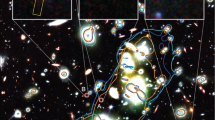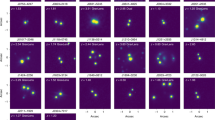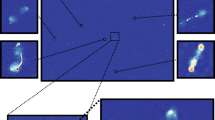Abstract
Walsh et al.1 originally suggested that the double QSO 0957 + 561 A, B might be images of the same object formed by a gravitational lens because of their remarkably similar optical spectra. Additional optical spectral data2 strengthen the evidence for a gravitational lens. Radio data at 5 GHz have shown a complex structure3,4. There are compact (<1 arc s) components closely coincident with the two QSOs; Pooley et al.3 suggested that the one near B may be extended ∼1.5 arc s, but the higher resolution data of Roberts et al.4 make it probable that B is, in fact, also compact. In addition, there are at least two extended components, one to the north-east producing more than half the total 5-GHz flux density, and a much weaker one to the west. Pooley et al. show that these two extended components have fairly steep spectral indices (−0.65) between 5 GHz and 408 MHz but the components close to the QSOs have relatively flat spectra. We have now tested the gravitational lens hypothesis using the greater resolution obtained by very long baseline interferometer (VLBI) measurements of the QSOs, with the European Network at 1,666 MHz. We have detected two apparently unresolved (≲20 marc s) sources with about the same separation as the optical objects and with flux densities of 44 and 32 mJy. These sources have the same flux density ratio as the small-diameter components detected in lower resolution 5-GHz maps but we see no evidence for the extended features in these maps. Our high resolution results are consistent with the gravitational lens hypothesis.
This is a preview of subscription content, access via your institution
Access options
Subscribe to this journal
Receive 51 print issues and online access
$199.00 per year
only $3.90 per issue
Buy this article
- Purchase on Springer Link
- Instant access to full article PDF
Prices may be subject to local taxes which are calculated during checkout
Similar content being viewed by others
References
Walsh, D., Carswell, R. F. & Weymann, R. J. Nature 279, 381–384 ( 1979).
Weymann, R. J. et al. Astrophys. J. Lett. 233, L43–L46 ( 1979).
Pooley, G. G. et al. Nature 280, 461–464 ( 1979).
Roberts, D. H., Greenfield, P. E. & Burke, B. F. Science 205, 894 ( 1979).
Clark, B. G. Proc. IEEE 61, 1242–1248 ( 1973).
Author information
Authors and Affiliations
Rights and permissions
About this article
Cite this article
Porcas, R., Booth, R., Browne, I. et al. VLBI Observations of the double QSO, 0957 + 561 A, B. Nature 282, 385–386 (1979). https://doi.org/10.1038/282385a0
Received:
Accepted:
Issue Date:
DOI: https://doi.org/10.1038/282385a0
This article is cited by
Comments
By submitting a comment you agree to abide by our Terms and Community Guidelines. If you find something abusive or that does not comply with our terms or guidelines please flag it as inappropriate.



